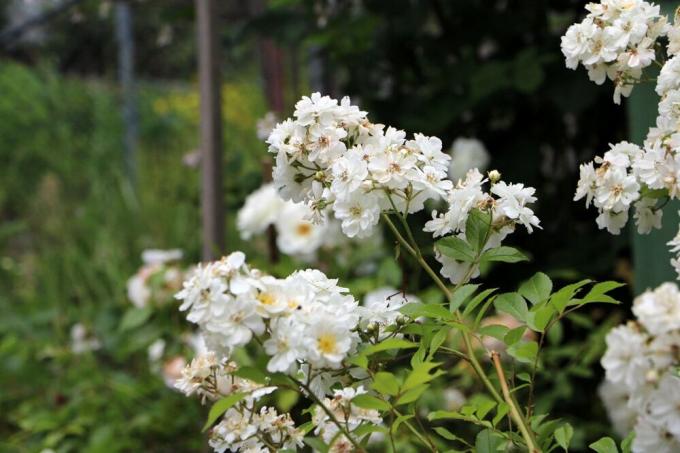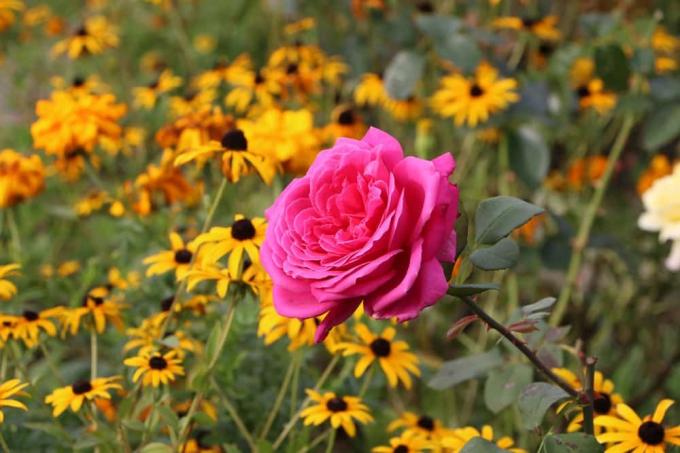

Table of contents
- growth
- Instructions
- time
- Tool
- varieties of roses
- Conclusion
Faded roses should be removed regularly by pruning to ensure that they continue to bloom. A rose bush has strong regenerative properties, so pruning will not damage it. On the contrary, faded inflorescences damage the plant, which quickly loses its strength and no more new flowers form. Only through targeted and periodic pruning of the faded roses does the plant remain vital and thriving. However, the cut must be targeted so that the rose bush does not become infected with pathogens.
growth
Rose bushes have a persistently great ability to regenerate, even from just a single rose flower the blossoms can develop back to their full size. The gardener doesn't do anything wrong without pruning the faded flowers, but the Rose bushes age over time and can regain their blooming joy and vitality in just a few years lose. The faded rose blossoms continue to be supplied with nutrients by the plant, which means that the plant loses strength unnecessarily. If these are not pruned, the energy goes into seed formation and no new buds are formed. The following aspects are crucial for growth:
- Faded flowers must be cut off, otherwise they will become old
- As a result, roses no longer form any more young shoots, especially in the ground area
- In this way, Rosenstock wilts over the years
- Cutting off stops the useless supply of the dead rose petals
- Pruning helps in the formation of new flowers
- Prune vigorously growing shoots more gently
- Start more radically with weakly growing shoots
- Without pruning, the branches grow too long in proportion
- The plant is gaining in volume, but the shoots are not strong enough
- Shoots that are too long can no longer withstand wind and weather and break off
- In addition, a rose bush looks much more attractive without faded flowers
Instructions

Although roses tolerate pruning quite well, the pruning must be done at certain points so that the plant is not damaged and can recover promptly. If the cut is made incorrectly, it can quickly become infected with bacteria and fungal pathogens. However, not only the faded rose petals should be cut off, but also the leaves underneath. This allows the plant to maintain a designated direction of growth. The following procedure has proven itself when pruning the faded rose petals:
- Start pruning about 0.5 cm above the first fully developed leaf, which is below the faded flower
- Cut after an outward-facing eye
- Cut diagonally away from a new shoot that is already visible
- Oblique cut prevents water from accumulating at the cut
- Stalks must never stand still
- Never break off or break off the flower
- Frayed breaks encourage entry of harmful pathogens
- Canceling will also help sprout puny buds
- Faded roses on extremely thin and weak branches may be cut lower
- Deep pruning encourages stronger growth
Tip:
The first leaf below the flower usually has only 3 leaves, whereas a fully developed leaf has more than 5 leaves. If possible, the first fully developed leaf should be left standing, but the inferiorly developed leaf can also be cut off.
time
The pruning of faded rose blossoms should be carried out in addition to the shaping care cuts. Therefore, the plant must be constantly monitored during its flowering period so that it can be removed relatively quickly:
- Cut out faded flowers throughout the summer
- Check the rose bush regularly
- Faded flowers should not remain on the plant for too long
- Constant removal of faded rose petals ensures strong and profusely flowering plants
- Warm days without rain are ideal
- Avoid too hot, too cold and too wet weather conditions
- Persistently high humidity leads to the penetration of pathogens at the interfaces
Tool

When pruning the roses, the right equipment is not only necessary, but imperative. The tool must meet high standards so that it can be used to make extremely smooth and precise cuts without unnecessarily damaging the plant. If the rose shoot is severely bruised or even torn, it often happens that harmful bacteria and fungi can penetrate the injured areas. As a result, the plant loses its resistance and becomes more susceptible to diseases. The following criteria are important when choosing tools for pruning roses:
- High-quality pruning shears are required for cutting roses
- Special rose scissors with a shape adapted to the needs are ideal
- Bypass scissors are like normal household scissors, two blades slide past each other
- Bypass scissors prevent bruising, especially with soft shoots
- Scissors with a bypass system require more effort, but it is worth it
- Anvil shears feature a sharp blade that strikes a straight plane
- Anvil shears simplify the cutting of thicker shoots
- However, scissors with an anvil system often lead to damaging bruises
- Always disinfect scissors well before use, sharpen if necessary
- To disinfect, either use denatured alcohol or burn the blades
- There are extended rose scissors for tall climbing roses
Tip:
Not only the roses should be protected from injuries, the gardener's hands also benefit from additional protection in the form of robust gloves. When working with the prickly thorns, these offer good protection against tears and cuts, which can lead to painful inflammation.
varieties of roses
The procedure for cutting off the faded rose blossoms also differs depending on the rose variety, which decisively determines the growth and development of the blossoms. These include the following varieties: bed and hybrid tea roses, climbing roses (flowering once or more), rambler roses, tree roses, shrub roses (flowering once or more), wild roses and dwarf roses. The following aspects should be observed with the rose varieties:
- In the case of poorly flowering shrub roses, cut back the lazy shoots by two-thirds
- In the case of bedding and hybrid tea roses, cut back older shoots more vigorously
- Climbing roses do not produce flowers in the first year of life
- Wild roses form beautiful and bright red hips, leave them standing
- For standard roses, generously cut off senile shoots in favor of young shoots
- With rambler roses, only cut back the strong, faded shoots, proceed carefully with the rest
- With dwarf roses, pay attention to a hemispherical cut
Conclusion
Rose blossoms should be cut out as soon as possible after they have faded, so that the plant does not unnecessarily feed the dead shoots. Therefore, the rose bushes should be checked regularly during the flowering period in summer in order to be able to act promptly. If faded roses get stuck on the plant, it will be weakened and will age over time. In the long run, aging leads to stunted shoots and weaker and weaker flowering. In addition, wilted flowers on a rose bush do not look particularly attractive and detract from the overall attractiveness. When pruning, the cutting point is crucial, this should be below the withered flower but still above the first fully developed leaf. However, inferiorly developed shoots may be cut off more radically, which also strengthens growth and flowering. Furthermore, the tool used for cutting is of great importance, it should always be clean and sharp. In this way, the plant is not disproportionately crushed and injured, because pathogens can penetrate more easily through cuts and permanently weaken the rose bush.
 garden editorial
garden editorial I write about everything that interests me in my garden.
Learn more about Rose

Ground cover roses: care from A – Z
All varieties of ground cover roses are attractive plants with an abundance of flowers consisting of single or double, single or multicolored and delicately scented flowers. Sometimes they even bloom several times a year. They are a low-maintenance and pretty alternative to green ground covers.

Pruning & caring for wild roses | Instructions for Hundsrose & Co.
Wild roses are the easy-care archetype of the rose, but even they cannot do without care in the garden. With the right care, wild roses such as the dog rose or the apple rose produce lush flowers and can be used in a variety of ways in the garden.

Rare Flowers and Bulbs: 20 types of flowers
Experiencing the magic of a species-rich flower meadow is a rare privilege. Intensive agriculture and forestry leave numerous plant and animal species little chance of survival. Reason enough to plant rare flowers and flower bulbs in your own garden and save them from perishing. These 20 types of flowers are floral beauties with a rarity value.

Dune rose, burnet rose, Rosa pimpinellifolia - care instructions
The dune rose or burnet rose is a "rose for all occasions", which brings a wealth of the most beautiful flowers into the garden with the lowest demands. In the article you will learn how easy it is to take care of the versatile rose.

Take care of old roses - transplant and cut properly
Beautiful newly designed garden, only the old roses are now really in the way? Read how to properly transplant and cut old rose bushes.

Tufted rose, Rosa multiflora, Multi-flowered rose - care & pruning
Tufted rose, Rosa multiflora, multi-flowered rose - as the plant is also called, the flowers and the scent are simply attractive. In order for both to be preserved for a long time and to enrich the garden, the plant must also be cared for accordingly and trimmed regularly. With the right instructions, this is also possible for laypeople.



